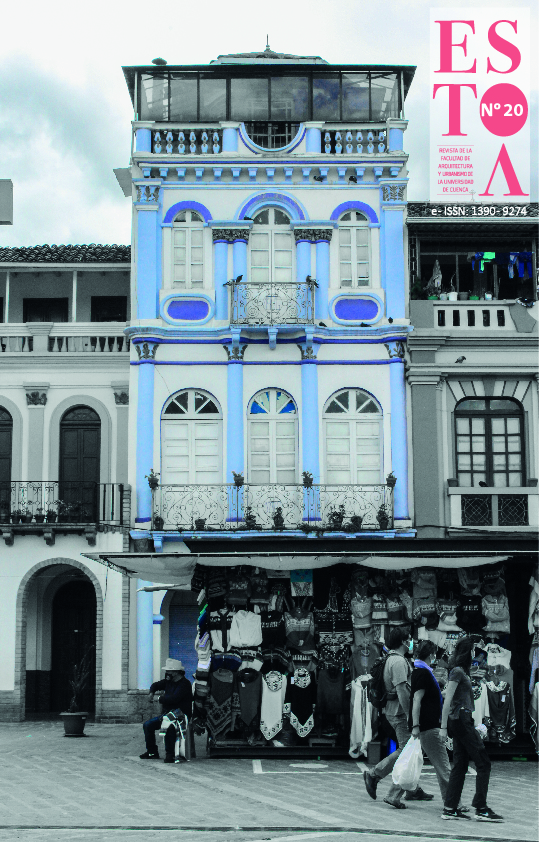Asian influences in the search for comfort in the Chilean colonial period: from the carpet to the estrado
DOI:
https://doi.org/10.18537/est.v010.n020.a06Keywords:
estrado, comfort, home, Hispanic America, Colonial PeriodAbstract
In the austere Chilean and Spanish-American colonial houses, a piece of furniture for daily use stood out: el estrado. Element that would have its origin in the textilatry that arose early in Central Asia and in Islamic culture and whose greatest exponent was the carpet, which made a way to the European world through the Flemish trade. This work aims to demonstrate the eastern origin of the estrado, through its Asian and later European transit until it arrived in America, and also to highlight the social role it acquired by becoming essentially feminine furniture within the space of the especially Chilean colonial house.
Downloads
References
Abad, C. (2003). El estrado: continuidad de la herencia islámica en los interiores domésticos zaragozanos de las primeras cortes borbónicas (1700-1759). Artigrama, (18), 375-392.
Aguilo Alonso, M. (1993). El mueble en España siglos XVIXVII. Ediciones Antiqvaria.
Alpers, S. (2020). El arte de describir. El arte holandés en el siglo XVII. Ampersand.
Araya Espinoza, A. (2008). Un imaginario para la mezcla. Mujeres, cuerpo y sociedad colonial. En S. Montecino (Ed.) Mujeres chilenas: fragmentos de una historia. Catalonia.
Araya, A. (1999). Cuerpos aprisionados y gestos cautivos: el problema de la identidad femenina en una sociedad tradicional (Chile 1700-1850). Nomadías: series monográficas, el género y las mujeres, aportes historiográficos, 1, 71-84.
Aste, R. (Ed.). (2013). Behind closed doors: Art in the Spanish American home, 1492-1898. New Orleans Museum of Art.
Bachelard, G. (2000). La poética del espacio. Fondo de Cultura Económica.
Bauer, A. (2002). Somos lo que compramos. Taurus.
Berg, M. y Eger, E. (2003). Luxury and Pleasure in Eighteenth-Century Britain. Palgrave MacMillan.
Bomchil, S. y Carreño, V. (2011). El Mueble Colonial de las Américas. Maizal Ediciones.
Campen, J., Corrigan, K. y Diercks, F., (2016). Asia in Amsterdam. Yale University Press.
Crowley, J.E. (2003). The Invention of Comfort. Johns Hopkins University Press.
Cruz O., I. (1996). El traje: transformaciones de una segunda piel. Ediciones Universidad Católica de Chile.
Csikszentmihalyi, M. y Halton, E. (1981). The Meaning of Things: Domestic Symbols and the Self. Cambridge University Press.
Danwerth, O. y Duve, T. (2019). Normatividades e instituciones eclesiásticas en el virreinato del Perú, siglos XVI–XIX. Max Planck Institute for Legal History and Legal Theory.
Diez, J. E. y Navarro, P. J. (2015). La casa medieval en la península Ibérica. Silex Ediciones.
Fierro, M. I. (2008). Las huellas del islam a debate. En Roldán Castro y M. M. Delgado Pérez (Eds). Las huellas del islam (pp. 73-96). Universidad de Huelva.
Gerritsen A. y Riello G. (2015). Writing Material Cultural History. Bloomsbury.
Golombek, L. (1988). The Drapped Universe of Islam. En P. Soucek (Ed.) Content and Context of Visual Arts in the Islamic World. Pennsylvania State University Press.
Graham, M. (1953). Diario de su residencia en Chile (1822) y de su viaje al Brasil (1823). Editorial del Pacífico.
Graves, M. S. (2016). Islamic art, architecture and material culture: New perspectives. BAR Publishing.
Irigoyen-García, J. (2016). “Como hacen los moros a los cristianos”: Raza, género e identidad cultural en “Tarde llega el desengaño” de María de Zayas. Revista canadiense de estudios hispánicos, 40(2), 357-370.
Kordić, R. (2005). Testamentos coloniales chilenos. Iberoamericana/ Vervuert.
López, M. del P. (1996). El estrado doméstico en Santafé de Bogotá en el Nuevo Reino de Granada. Ensayos: Historia y Teoría del Arte, (2), 135-172. https://revistas. unal.edu.co/index.php/ensayo/article/view/46450
McNeil, P. y Riello, G. (2016). Luxury a rich history. Oxford University Press.
Oledzka, E. (2016). Medieval & Renaissance interiors in illuminated manuscripts. British Library.
Peck, A. y Bogansky, A. (2013). Interwoven globe. The world Textile Trade 1500-1800. Thames&Hudson.
Potvin, J. (2015). Oriental Interiors, Design, Identity and Space. Bloomsbury Academic.
Rice, Ch. (2007). The emergence of the interior. Routledge.
Rodríguez Bernis, S. y Gisbert Marco, I. (1990). Mueble español: estrado y dormitorio. M.E.A.C. Dirección General de Patrimonio Cultural.
Roller, M. (2006). Dining Posture in Ancient Rome: Bodies, Values, and Status. Princeton University Press.
Rosas Lauro, C. (2019). Género y mujeres en la historia del Perú: del hogar al espacio público. Fondo Editorial de la Pontificia Universidad Católica del Perú.
Rueda, J. O. (2015). Bekleidung. Los trajes de la arquitectura. Fundación Arquia.
Ruiz Valdés, J. (2005). Cultura material y sociedad colonial: Un estudio desde documentos notariales. Santiago 16901750. Universidad de Chile.
Sadan, J. (1976). Le Mobilier au Proche-Orient médiéval. Brill Archive.
Sagredo Baeza, R. y Gazmuri Riveros, C. (2005). Historia de la vida privada en Chile. Taurus.
Schmidt, B. (2015). Inventing Exoticism, Geography, Globalism and Europe’s Early Modern World. University of Pennsylvania Press.
Simmel, G. (2005). La metrópolis y la vida mental. Revista Bifurcaciones: revista de estudios culturales urbanos, (4), 1-10.
Steward, S. (2012). On Longing: Narratives of the Miniature, the Gigantic, the Souvenir, the Collection. Duke University Press Books.
Stuven Vattier, A. y Fermandois, J. (2011). Historia de las mujeres en Chile (1a. ed.). Aguilar.
Taylor, M. (2006). Furniture is a kind of dress: interiors as projection of self. En T. McMinn, J. Stephens, y S. Basson. (Eds). Contested Terrains, XXIII Annual Conference of the Society of Architectural Historians (pp. 530-555). Proceedings.
Valenzuela Márquez, J. (2007). Historias urbanas: homenaje a Armando de Ramón. Universidad Católica de Chile.
Vicuña, M. (2012). La política de las formas. Universum, 27(2), 237–247.
Published
How to Cite
Issue
Section
License
Copyright (c) 2021 Estoa. Revista de la Facultad de Arquitectura y Urbanismo

This work is licensed under a Creative Commons Attribution-NonCommercial-ShareAlike 4.0 International License.
The Journal declines any responsibility for possible conflicts derived from the authorship of the works that are published in it.
The University of Cuenca in Ecuador conserves the patrimonial rights (copyright) of the published works and will favor the reuse of the same ones, these can be: copy, use, diffuse, transmit and expose publicly.
Unless otherwise indicated, all contents of the electronic edition are distributed under a Creative Commons Attribution-NonCommercial-ShareAlike 4.0 International License.




